Traditionally enterprises grew their systems and IT infrastructure out of necessity as the business grew and connected the various IT applications with minimum planning. Stove pipe applications were pretty much the norm. These applications were connected in a point to point manner with no clear indication of process flow. But as the pace of business change accelerated connecting systems became a major roadblock. Then in the late 1990’s EAI (Enterprise Application Integration) emerged as a planned way to integrate the array of IT applications. EAI became a top priority in many enterprises.
Traditionally enterprises grew their systems and IT infrastructure out of necessity as the business grew and connected the various IT applications with minimum planning. Stove pipe applications were pretty much the norm. These applications were connected in a point to point manner with no clear indication of process flow. But as the pace of business change accelerated connecting systems became a major roadblock. Then in the late 1990’s EAI (Enterprise Application Integration) emerged as a planned way to integrate the array of IT applications. EAI became a top priority in many enterprises. With the internet and the creation of the extended enterprise – B2B (Business to Business) integration became possible.
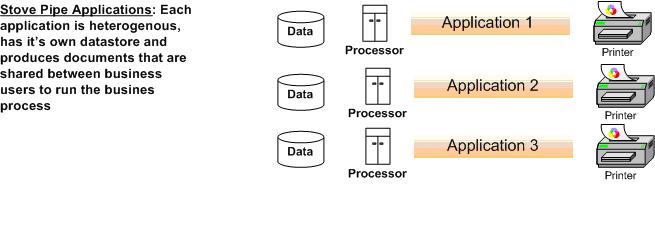
Stove pipe application architecture.
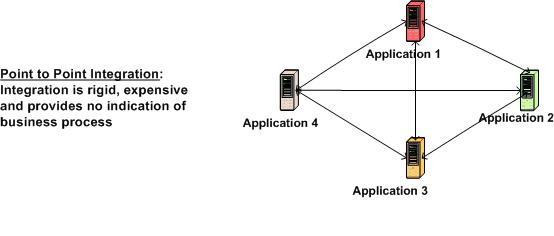
Point to point integration.
As shown in figure 2, in large organizations point-to-point integration has created spaghetti architecture. I have consulted with clients who have not been able to retire legacy systems because of the spaghetti architecture problem. Stove pipe applications support business processes in a fragmented and discontinuous manner.
EAI (Enterprises Application Integration):
Sophisticated EAI suites like BizTalk, Tibco etc came to the market. However despite increasingly sophisticated EAI applications, enterprise application integration remains difficult and does not meet business objectives. Enterprise integration has to deal with multiple heterogeneous applications running in different locations. Figure 3 shows a typical EAI architecture within an enterprise. Using publish and subscribe technology the EAI system senses any data change in the source system and updates the destination systems. Also scheduled batch jobs are used to transfer data. Figure 4 shows a B2B (Business-to-business) integration architecture. However EAI failed to deliver its promise and some of the below business issues still persisted
- Low visibility of business operational performance that provide.
- EAI is data centric and not process centric.
- EAI could not keep up with business process change.
- EAI does not address the business process.
- EAI solutions are technically very complex, need specialized skills and are very expensive to maintain.
Basically EAI addressed the problem of connecting applications and transferring data. EAI is not going away. With BPM the focal point is going to be the process and not data. BPM will leverage the investment made by corporations.
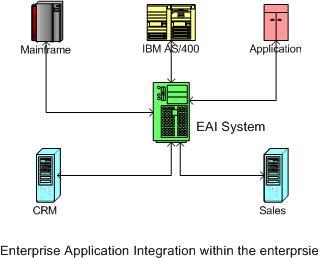
Depicts internal EAI architecture connecting heterogeneous systems.
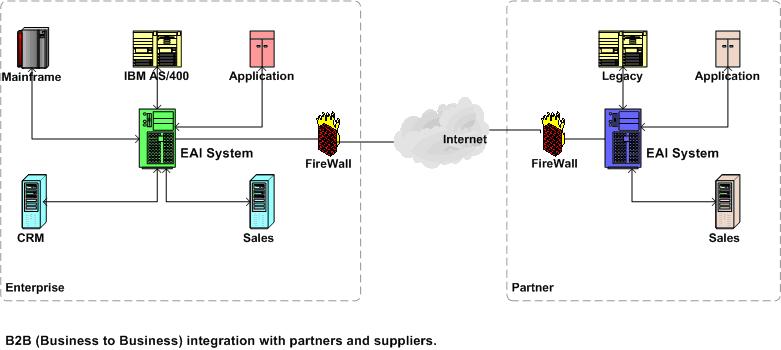
Depicts B2B integration architecture connecting heterogeneous systems across the enterprise.
EAI in BPM
Traditionally the focus of EAI was data and data change. EAI connected applications around data. Data is the first class citizen in EAI. In EAI anytime data changed in the source it was automatically propagated to other connected applications. BPM leverages the application connectivity aspect of EAI but changes the focus to process. The business process as it executes uses EAI technology to connect to disparate systems and propagate data. Below table indicates the difference between standalone EAI and EAI in BPM
| Capability | EAI | EAI in BPM |
| Data Flow | Automated Application to Application Data synchronization. | Business Process could involve both Application to Application data flow and human interaction to enter/review/update data in the flow. |
| Duration | Simple and short running flows of Data | Business Processes could be very complex and long running. |
| EAI is a subset of what a BPM system offers. BPM products must have built in application integration capabilities so that existing applications can be leveraged. The most optimized way to integrate with existing applications is using Web services. Nevertheless BPM products need to provide integration capabilities built in and in partnership with third-party EAI products. |
Capability EAI EAI in BPM
Data Flow Automated Application to Application Data synchronization. Business Process could involve both Application to Application data flow and human interaction to enter/review/update data in the flow.
Duration Simple and short running flows of Data Business Processes could be very complex and long running.
EAI is a subset of what a BPM system offers. BPM products must have built in application integration capabilities so that existing applications can be leveraged. The most optimized way to integrate with existing applications is using Web services. Nevertheless BPM products need to provide integration capabilities built in and in partnership with third-party EAI products.
For complex business processes where multiple heterogeneous applications are process participants the ability to integrate and orchestrate the applications by the BPM system is critical.
Web Services
The internet has created universal connectivity. The extended enterprise uses the internet to connect to its customers, partners and suppliers. Web services have forever changed the way we think about enterprise application and architectures. Web services allow language, platform and location independent connectivity using open universal standards like HTTP. Web services allow heterogeneous applications to talk to each other without expensive EAI software. Web services enable existing application to be exposed as services. SOA (Service Oriented Architecture) is a collection of loosely coupled web services that communicate with one another. SOA where business logic and business processes are exposed to other processes and software through standard services.
| BPM and web services compliment each other. Web services can be used by the BPM system as a way to integrate other IT applications in a process centric way. Secondly, the BPM system itself can be exposed as a Web service and other applications and systems can initiate a process through the BPM system. |
BPM and web services compliment each other. Web services can be used by the BPM system as a way to integrate other IT applications in a process centric way.
Secondly, the BPM system itself can be exposed as a Web service and other applications and systems can initiate a process through the BPM system.
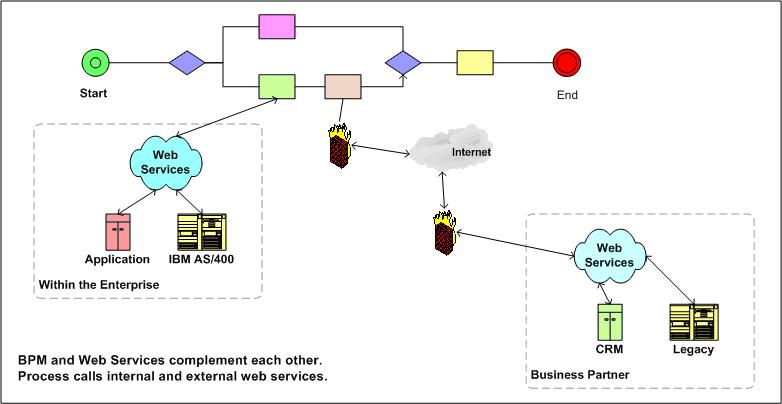
A business process calls internal and external web services.
Figure 5 shows a business process invoking internal and external web services. External web services are invoked over the internet and can be used to collaborate with external partners and suppliers. Trust me BPM and web services are a powerful combination and when used together the combination creates mind blowing flexibility, loosely coupled integration and excellent opportunities for collaboration and business process outsourcing.
BPM and Web Services – a powerful combination
BPM and web services will dominate the next few years. This combination creates a rich matrix of process possibilities which if I where to describe in a few words I would say “process everywhere”. BPM and web services facilitate a new breed of process automation and innovation in the extended enterprise. The dynamic combination of BPM and web services can truly create the following process possibilities
- Process Plug and Play.
- Process embedded within processes.
- Universal business processes.
- Specialized business processes.
- Process services.
- Process collaboration.
Web services are becoming a major catalyst for the evolution of BPMS. The ability to dynamically invoke web services in a synchronous or asynchronous manner from within the business process during process orchestration is enabling the creation of new industries and process innovation. In fact the cost and complexity of BPM solutions can be reduced through the use of web services. There are certain challenges that need to be kept in mind for complex business processes like
- Coordination of asynchronous communication between the business process and the web services.
- Long running transactions during process orchestration
- Correlate message exchanges between the business process and web services
EBay is the worlds biggest online auction site. Thanks to internet, rock solid auction process and web services eBay has converted itself to the biggest flea market of the planet. Nearly 40% of the product listing are generated by web services. By making eBay accessible through web services, business are empowered to leverage eBay’s trading platform and auction process. Businesses are embedding eBay’s auction web service into their own business processes like traditional sales, delivery and procurement processes. This new plug and play process and web service architecture is generating efficiencies and profits for forward looking companies.
| Processes managed enterprises are creating new industries by making available internal business functions as pay-per-use processes and creating new industries. |
Processes managed enterprises are creating new industries by making available internal business functions as pay-per-use processes and creating new industries.
Figure 6 shows how eBay’s auction process is exposed as a web service. Vendor’s delivery and procurement processes call eBay’s auction process over the internet using web services. This real time example shows process “plug and play” and “pay-per-use” process architecture. Vendors now can embed eBay’s super efficient auction process into their own business processes and give eBay a service fee. EBay’s auction process communicates back to the vendor’s process and the vendor has complete visibility of product auction and complete control. BPM and SOA together will create virtual enterprises like eBay. The point is organizations do not have to create everything on their own. They can create innovative processes that contain sub processes created and managed by others.
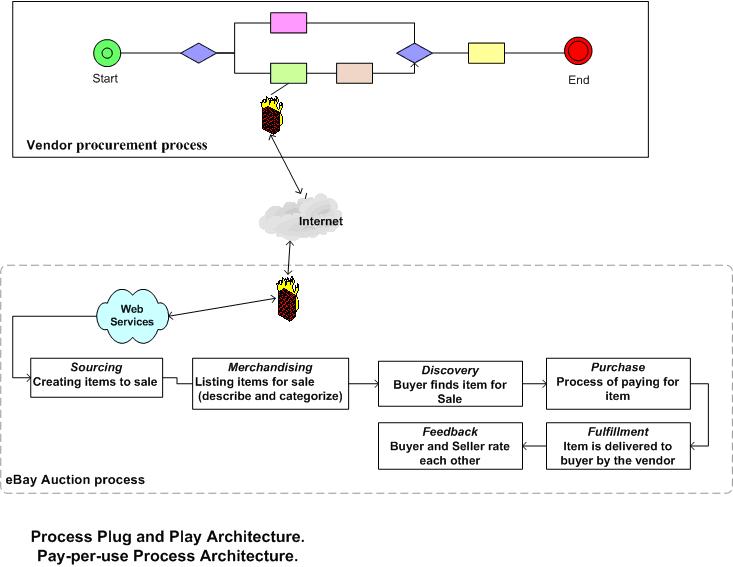
eBay’s auction process exposed as a Web service.
Using BPM and Web services in tandem may allow the extended enterprise to extract far more value of internal applications and leverage external business processes like we have seen in Figure 5. As BPM moves towards mainstream adoption, we are going to see an evolution of business processes and services. Web services will quietly merge behind the scenes with BPMS, and we are likely to see processes every where. Universal services like currency rate services will be offered and maintained by some company. All other business processes will just consume the currency rate service.
Business process and web services combination is already changing the business landscape. Business processes will invoke web services, but it might be the end consumer interested in the results of the web service. Dell might use web service from UPS in its direct process model to offer its consumer package tracking. Dell consumers go to UPS we site to track their packages once Dell gives them a confirmation number. Such kind of process handoff and process specialization is going to be the norm going forward.

















